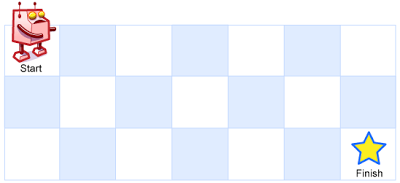A robot is located at the top-left corner of a n x m grid (marked 'Start' in the diagram below).
The robot can only move either down or right at any moment of time. The robot is trying to reach the bottom-right corner of the grid (marked 'Finish' in the diagram below).
Now consider obstacles are placed in some of the grid's cells. How many unique paths would there be?

An obstacle and empty space is marked as 1 and 0 respectively in the grid.
Note: n and m will be at most 100.
It is guaranteed that the answer can be represented as a 32-bit integer.
Example 1:
Input: [ [0,0,0], [0,1,0], [0,0,0] ] Output: 2 Explanation: There is one obstacle in the middle of the 3x3 grid above. There are two ways to reach the bottom-right corner: 1. Right -> Right -> Down -> Down 2. Down -> Down -> Right -> Right
The core challenge of this problem is to find the number of unique paths from the top-left corner to the bottom-right corner of a grid, considering that some cells may contain obstacles. The robot can only move right or down, which limits the possible paths.
This problem is significant in various applications such as robotics navigation, game development, and pathfinding algorithms. A common pitfall is not accounting for obstacles correctly, which can lead to incorrect path counts.
To solve this problem, we can use dynamic programming. The idea is to create a 2D array dp where dp[i][j] represents the number of unique paths to reach cell (i, j).
A naive solution would involve recursively exploring all possible paths, but this approach is not optimal due to its exponential time complexity.
We can optimize the solution using dynamic programming:
dp with the same dimensions as the grid.dp[0][0] to 1 if there is no obstacle at the starting cell.dp array based on the values from the top and left cells, considering obstacles.Here is a step-by-step breakdown of the dynamic programming approach:
dp of the same size as the grid.dp[0][0] to 1 if grid[0][0] is 0 (no obstacle).dp[i][j] to 0.dp[i][j] to the sum of dp[i-1][j] and dp[i][j-1], considering boundary conditions.dp[n-1][m-1] as the result.#include <vector>
using namespace std;
// Function to calculate unique paths in a grid with obstacles
int uniquePathsWithObstacles(vector<vector<int>>& grid) {
int n = grid.size();
int m = grid[0].size();
// If the starting or ending cell has an obstacle, return 0
if (grid[0][0] == 1 || grid[n-1][m-1] == 1) {
return 0;
}
// Create a 2D dp array initialized to 0
vector<vector<int>> dp(n, vector<int>(m, 0));
// Initialize the starting cell
dp[0][0] = 1;
// Fill the dp array
for (int i = 0; i < n; ++i) {
for (int j = 0; j < m; ++j) {
if (grid[i][j] == 1) {
dp[i][j] = 0; // No path through an obstacle
} else {
if (i > 0) {
dp[i][j] += dp[i-1][j]; // Paths from the top
}
if (j > 0) {
dp[i][j] += dp[i][j-1]; // Paths from the left
}
}
}
}
// Return the number of unique paths to the bottom-right corner
return dp[n-1][m-1];
}
The time complexity of this approach is O(n * m) because we iterate through each cell in the grid once. The space complexity is also O(n * m) due to the additional 2D array dp.
Consider the following edge cases:
Each of these cases should be tested to ensure the algorithm handles them correctly.
To test the solution comprehensively, consider the following test cases:
Using a testing framework like Google Test can help automate and manage these test cases effectively.
When approaching such problems, consider the following tips:
In this blog post, we discussed the problem of finding unique paths in a grid with obstacles. We explored a dynamic programming approach to solve the problem efficiently and provided a detailed explanation of the algorithm and its implementation in C++. Understanding and solving such problems is crucial for developing strong problem-solving skills and preparing for technical interviews.
For further reading and practice, consider the following resources:
Our interactive tutorials and AI-assisted learning will help you master problem-solving skills and teach you the algorithms to know for coding interviews.
Start Coding for FREE